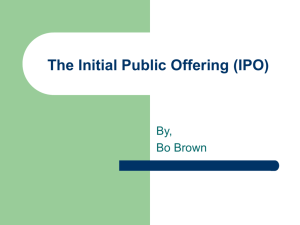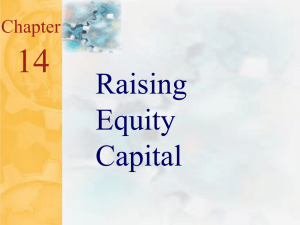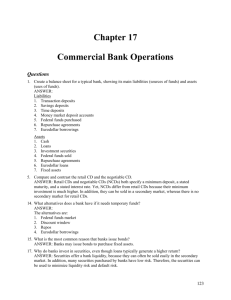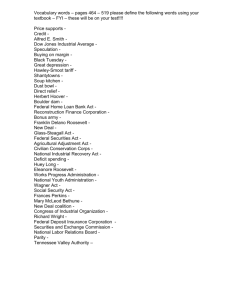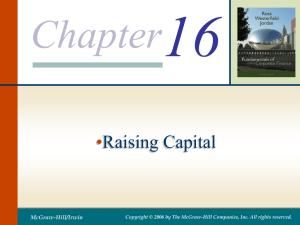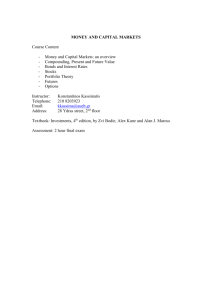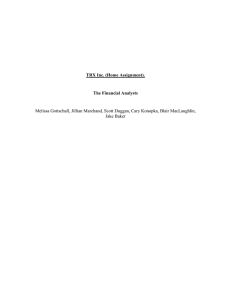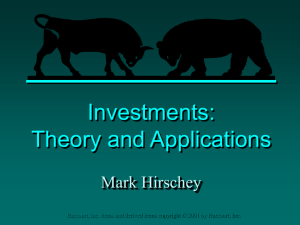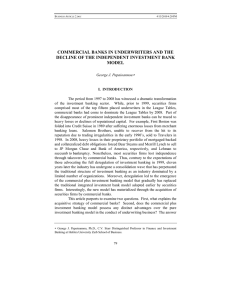Lecture 14: Investment Banking
advertisement
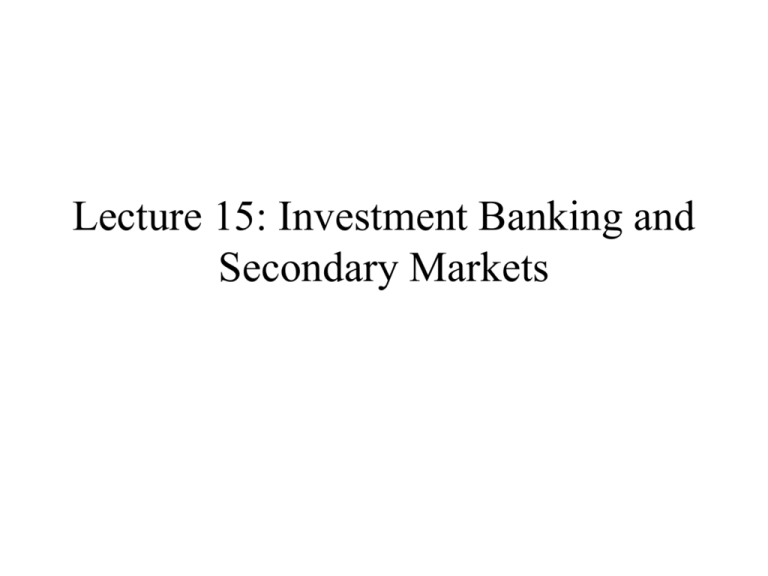
Lecture 15: Investment Banking and Secondary Markets Glass-Steagall Act 1933 • The modern concept of “Investment Bank” was created in the Glass-Steagall act (Banking Act of 1933). Glass Steagall separated commercial banks, investment banks, and insurance companies. • Carter Glass, Senator from Virginia, believed that commercial banks securities operations had contributed to the crash of 1929, that banks failed because of their securities operations, and that commercial banks used their knowledge as lenders to do insider trading of securities. Investment Banks • Bulge bracket firms: First Boston, Goldman Sachs, Merrill Lynch, Morgan Stanley, Salomon Brothers, Lehman Brothers. • Traditionally were often partnerships, but partnership form is disappearing. Controversy over Glass Steagall • Prof. George Benston showed that unregulated banks have lower failure rate. • Other countries (Germany, Switzerland) have always allowed universal banking • In 1990s, regulators nibbled away at Glass Steagall by allowing commercial banks to engage in certain securities operations Graham-Leach Act 1999 • President Clinton November 1999 signs Graham-Leach Bill which rescinded the Glass-Steagall Act of 1933. • Consumer groups fought repeal of GlassSteagall saying it would reduce privacy. Graham-Leach calls for a study of the issues of financial privacy • Mergers among Commercial Banks, Investment Banks & Insurance Companies Travelers’ Group (insurance) and Citicorp (commercial bank) 1998 to produce Citigroup, on anticipation that Glass-Steagall would be rescinded. Brokerage Smith Barney • Chase Manhattan Bank (commercial bank) acquires JP Morgan (investment bank) (2000) for $34.5 billion • UBS Switzerland buys Paine Webber (brokerage) 2000 • Credit Suisse buys Donaldson Lufkin Jenrette (investment bank) 2000 Underwriting of Securities • Issuance of shares and corporate debt • Seasoned issue versus IPO • Underwriter provides advice for issuer, distribution of securities, sharing of risks of issue, and stabilization of aftermarket. • Underwriter also “certifies” the issue by putting its reputation behind the issue. Moral Hazard Problem Mitigated by Investment Banks • Firms have incentive to issue shares when they know their earnings are only temporarily high. • This problem can be “solved” by resorting to bank loans instead of new equity • Problem can also be solved by issuing security with an investment bank that has a reputation to protect. • Studies show that investment banks that repeatedly underprice or overprice issues suffer a market share loss afterwards. Two Basic Kinds of Offerings • Bought deal (synonym: Firm commitment offering): The underwriter agrees to buy all shares that are not sold • Best efforts: the underwriter says that if the issue is not sold, deal collapses. The Underwriting Process I • Prefiling period • Advise issuers about their choices • Agreement among underwriters, designates manager, fees • Filing of registration statement with SEC, begins cooling-off period • Cooling off period – distribute preliminary prospectus (red herring), nothing else The Underwriting Process II • Call prospective clients for indication of interest • Due diligence meeting between underwriter and corporation • Decide on offering price, • underwriting agreement, which underwriter sells what • Dealer agreement, dealers purchase from underwriters at a discount from public price • Effective date • Support the price in the aftermarket Stabilization • A form of market manipulation by the underwriter near the time of the issue that is permitted by the SEC • Underwriting syndicate legally allowed to conspire to “fix” prices in market until entire issue is sold out From a 1929 Textbook on Investment Banking “In floating any new issues of securities, therefore, the seller desires to have conditions so shaped that the price of the issue will remain stable, or perhaps it will rise slightly, during the period in which the securities are being absorbed by the market. . .establishing a favorable psychological attitude of investors. . The term manipulated market is not altogether a misnomer.” The Tombstone • Newspaper announcements of securities’ issues, listing underwriting syndicate • Why called tombstones? Origin of term forgotten. Resemblance? • The only kind of ad allowed during cooling-off period • Cross between birth announcement and obituary. Tombstones appear after the securities have already been sold, but of course they are now on the market. • Investment bankers love to read them Variations on the Usual Underwriting Process • Auction Process (competitive bidding underwriting) various syndicates bid on the issue • Preemptive rights offering: existing shareholders have rights to buy issue below market value • Directly Public Offering (DPO): Company itself sells its securities directly to public, usually over the web. Small firms. Example: Internet Ventures, a web service provider, raised $3.8 million in 1998 by advertising the securities to its customers on the web. Private Placement • Sold only to “sophisticated” investors, exempt from SEC registration. • Regulation D: Private issues cannot be advertised, defines sophisticated investors • SEC has provided that privately placed securities cannot be sold for two years after purchase. • SEC Rule 144a April 1990 eliminates two-year holding period for institutions with over $100 million in the security Initial Public Offerings • Price tends to jump up immediately after an IPO is issued. • Apparently leave money upon the table Poor Long-Run Performance of IPOs • Jay Ritter, Journal of Finance, 1991 • Although average IPO earns a +16% return on the first day, this return tends to be offset over the next three years. Why This Performance of IPOs? • Impressario Hypothesis: analogy to sellers of tickets to concerts Survey of IPO Investors • “Do you think that investors expect reputable underwriters to take some account of true investment value in deciding the offering price in an IPO, rather than just the price the market will bear on the day of the offering?” 84% agree Survey of IPO Investors • Have you done any calculations of what the true fundamental value of a share in the company was, and compared the price of a share with this value? – 80% no.
